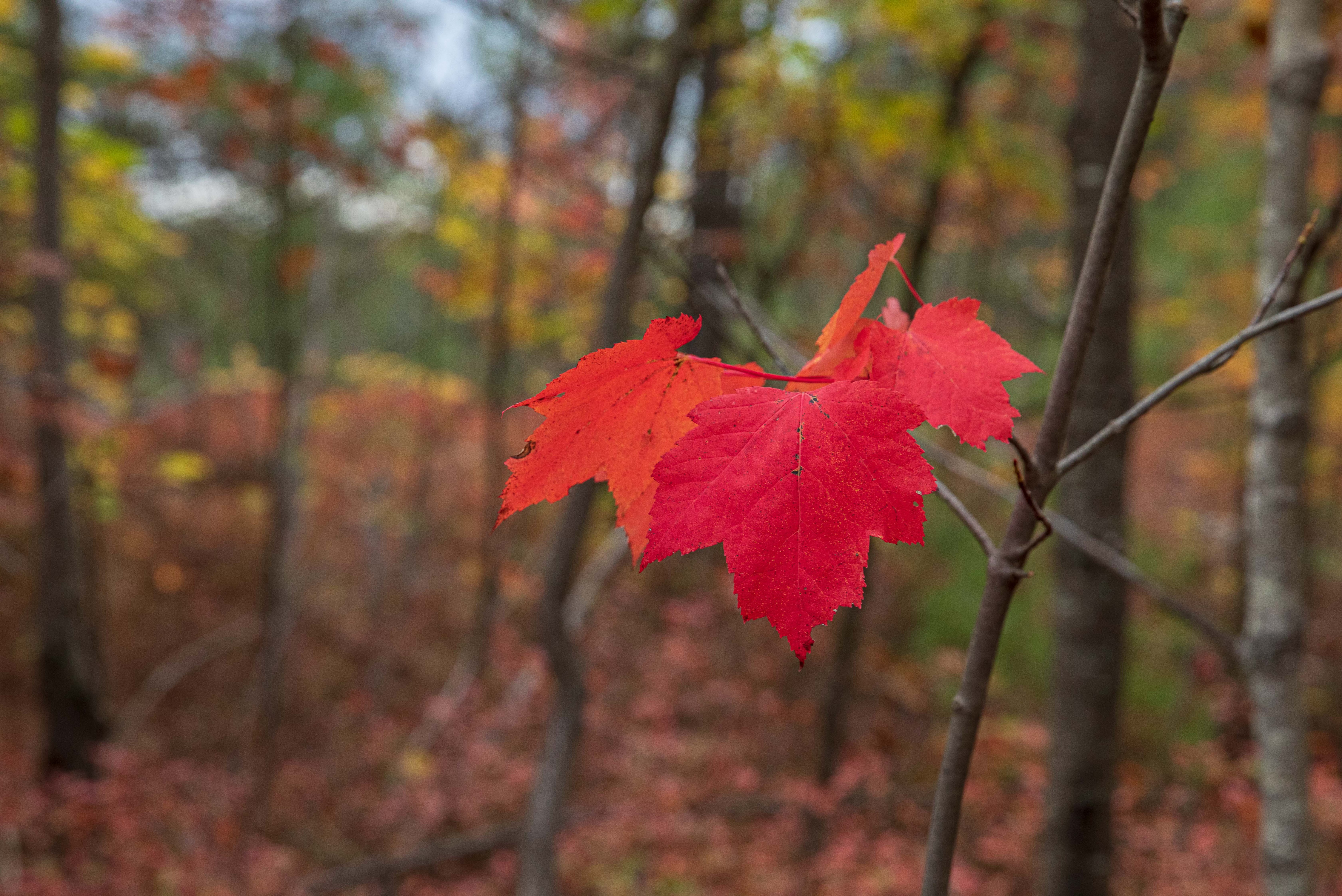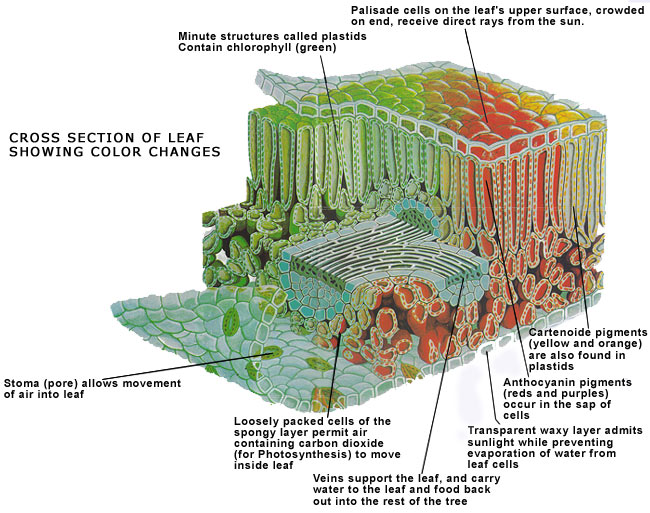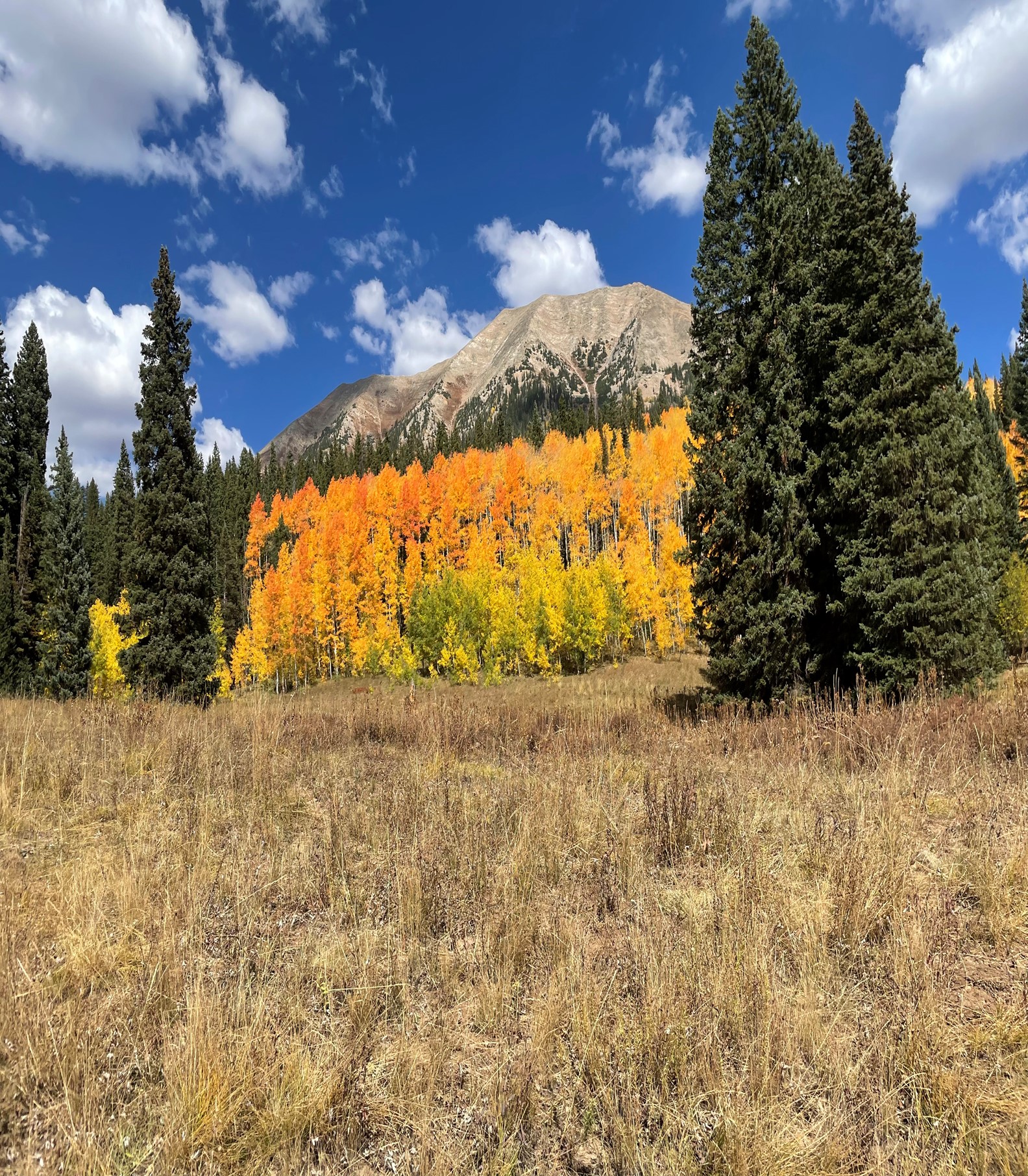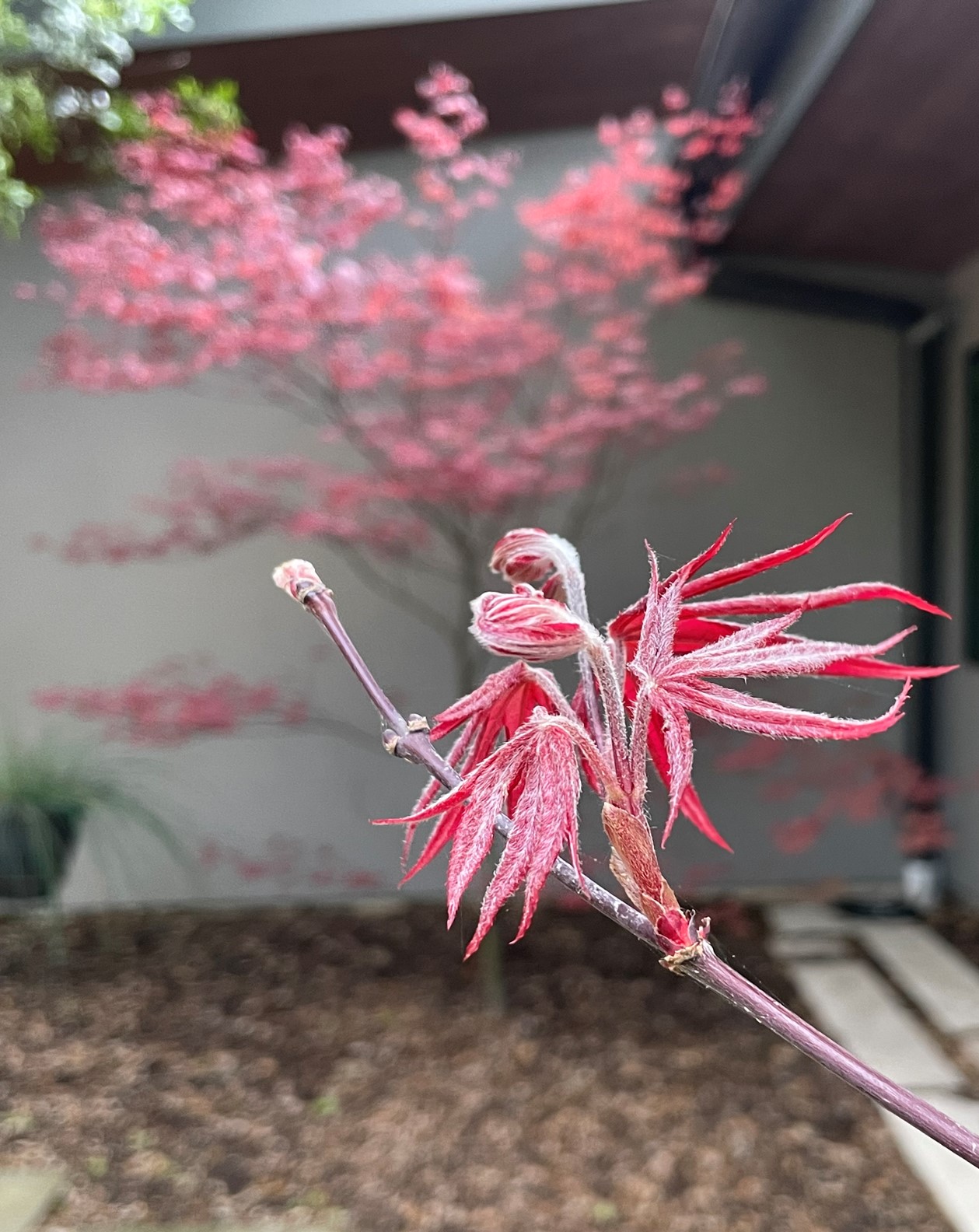
Credit: Ann Laubach
Leaves naturally turn yellow in the fall, when green chlorophyll fades to reveal the golden pigments already in them.
But it takes energy to turn leaves red, and not all trees can do it. Why?
Scientists have three hypotheses:
The first is sunblock. Red pigments protect the leaves better than yellow, allowing them to stay on branches longer, so that trees can harvest more nutrients before they fall.
The second has to do with insects. In autumn, aphids feed on tree leaves.
Researchers found that aphids are five times more attracted to yellow than red, so the red pigments may keep aphids away.
The third is related—but geologic. More than a hundred tree species produce red leaves in North America and East Asia, but only a few do in Europe.
During the last glacial advance, as ice descended southward, trees and animals had to migrate ahead to survive.
In America and Asia, with no east–west mountain ranges to block them, trees migrated easily—but so did their insect pests, encouraging the trees to produce red leaves.
In Europe, east–west mountain ranges blocked tree and insect migration, causing both to go extinct locally. Without those pests, most trees that repopulated those regions didn’t develop red pigments.
The real reason may be a combination, or something else entirely—a reminder that science is a process, not an outcome, and there is much left to discover.
Background
Synopsis: Trees get autumn yellow leaves for free, but, right when they are about to drop the leaves anyway, some actively expend energy to manufacture the anthocyanins that produce red leaves. Entire forests blaze red in North America and East Asia, while Scandinavian and European forests have a predominantly golden glow. From individual trees to entire species, scientists have ideas about why trees adapted red leaves—one even involves geology.
- In Earth’s temperate regions, the autumn season is marked by the metamorphosis of deciduous tree leaves from green to a riot of colors ranging from yellows to deep reds.
- In a previous EarthDate (ED-127 Fall Colors), we talked about the process that causes leaves to change color in the fall.
- In spring, new leaves start out with carotenoids (gold) and chlorophyll (green) pigments in plastids that line their cell walls, making them a light green.
- Chlorophyll is the engine of photosynthesis, converting light energy into chemical energy as it synthesizes sugars in the plant’s chloroplasts, while carotenoids help trap solar energy and protect the leaf from environmental stressors.

Cross section of a leaf showing the location of pigments. Green chlorophyll and gold carotenoids (yellow xanthophyll and orange carotene) are fat soluble and occur in the cell walls while red anthocyanins are water soluble and occur in the vacuoles of the cells.
Credit: USDA Forest Service, public domain, via Wikimedia Commons - Plants must continuously produce these green and gold fat-soluble compounds throughout the growing season. Magnesium, nitrogen, iron, carbon and hydrogen are necessary for the synthesis of chlorophyll.
- As warm temperatures and sunlight encourage photosynthetic processes, chlorophyll production increases, turning healthy leaves deeper and deeper green through the summer, further masking the gold carotenoid pigments.
- In fall, as days become shorter and temperatures begin to drop, chlorophyll production slows as the green pigment breaks down into colorless metabolites.
- The tree harvests sugars, nitrogen and other nutrients from its leaves for winter storage in its trunk and roots in preparation for the following year’s spring burst of growth.
- With less chlorophyll in the leaves, the carotenoids become visible again, revealing dazzling yellow to orange leaves.
- This golden display is passive, requiring no additional expenditure of energy.
- However, in some trees, the yellow color show is not enough.
- These trees turn shades of red to purple by using sugars to manufacture anthocyanin pigment, an antioxidant that also produces the hues of familiar foods like raspberries and blueberries.
- Trees that consistently produce red anthocyanins include red maple, dogwood, red oak, scarlet oak, sumac and sassafras.
- Not all trees can make anthocyanins.
- There are two principal hypotheses from different biological disciplines regarding why plants expend the extra energy to produce anthocyanins when they could bank the sugars for the following spring. The answer may be a combination of both.
- Focusing on individual trees, plant physiologists favor photoprotection:
- As nights get cooler, the vascular system used to transport nutrients out of the leaves and into winter storage start to contract and chemical reactions slow.
- If autumn days are sunny and warm, photosynthesis continues, but if nights are too cool, transport of the sugars produced decelerates, triggering active production of anthocyanins from the leaf’s excess glucose.
- This protective water-soluble coloration is stored in the vacuoles of cells, acting like sunscreen by shading chloroplasts to slow photosynthesis.
- The antioxidant properties of anthocyanins quench reactive oxygen species, preventing UV damage and prolonging the life of the leaves.
- These effects give the tree more time to harvest nutrients before leaf drop.
- The sunnier the days and cooler the nights, the more protective anthocyanins are generated to produce more brilliant red to purple color displays.
- If temperatures drop below freezing too early, trees will drop their leaves before resorbing the nutrients and may struggle the following spring.
- Under stress, plants may also turn to production of anthocyanins.
- Cooler temperatures may cause trees at higher elevations to develop more red color.
- Trees in nitrogen-poor soils tend to turn red earlier to hold onto leaves longer, enabling a greater harvest of nitrogen. Trees that live symbiotically with nitrogen fixing bacteria, like alders, don’t need nitrogen resorption so don’t put on red colors.

At the base of Colorado’s Gothic Mountain, aspen higher on the slope tend to have more red color. This could reflect nitrogen depleted soils or lower temperatures along the hilltop.
Credit: Juli Hennings, Bureau of Economic Geology - In the face of drought, anthocyanins help to regulate water and electrolyte balance in plants.
- Young leaves may start out red to protect the machinery of photosynthesis as it gets up and running in the spring.

Spring growth on maple trees is protected by anthocyanin reds as photosynthesis gets underway, preventing chemical imbalances and fending off harmful insects.
Credit: Juli Hennings, Bureau of Economic Geology
- Evolutionary biologists prefer coevolution between species of deciduous trees and bugs.
- In this hypothesis, red warns parasitic insects away from the leaves as a result of the long evolutionary war between trees and the insects that use them as hosts.
- Insects consume tree tissue and are vectors for pathogens like fungi, viruses and bacteria that could harm their hosts.
- Red may signal bad flavor or toxicity, deterring pests like aphids.
- Experiments have shown that aphids are about five times more attracted to the color yellow than to red. They appear to like yellow twice as much as green.
- During summer, aphids live on leafy herbaceous plants, but in fall, they move to trees and suck amino acids from the tree leaves before laying eggs that hatch into amino acid sucking larvae in the spring, robbing the tree of nutritional resources when it most needs them for growth. Then the young aphids move back to leafy bushes for summer.
- More than 250 species of trees that can produce anthocyanins also coevolved with parasitic insects, incentivizing red coloration.
- But colors vary by region also. North American forests blaze a range of colors from yellow to orange to deep red in autumn, but northern European forests, especially those in Scandinavia, glow primarily yellow gold.
- Of the 290 species of trees that produce red leaves, only four exist in Scandinavia and only 24 in the rest of Europe—compare that to North America with 89 species and East Asia with 152 species that blaze red.

Left: In northern Sweden, yellow trees of Lapland light up valleys in this Landsat 8 image.
Right: Red autumn foliage dominates northeastern New York’s Adirondack Mountains in this Landsat 9 image.
Credit: NASA Earth Observatory
- Of the 290 species of trees that produce red leaves, only four exist in Scandinavia and only 24 in the rest of Europe—compare that to North America with 89 species and East Asia with 152 species that blaze red.
- Researchers recently put forth a geological hypothesis regarding why such a profound regional variation in fall color might occur.
- In the Pleistocene Epoch, as glaciers crept southward, plants and animals had to migrate ahead of them for survival.
- In North America and eastern Asia, major mountain chains are oriented north–south, allowing easy migration southward. This is documented by analysis of pollen spores in southern lake cores of species that only exist in the north today.
- But Europe’s Alpine orogenic belt is oriented east–west, so that glaciers trapped species against the mountains, causing extirpation—local extinction.
- Why would that influence the need for red coloration in trees? Recall the coevolution pest protection hypothesis. As trees migrated southward to be trapped against the Alps, tree species were extirpated but so were their insect pests. The Alps were also a barrier to northward migration of species after glaciation.
- With their pests exterminated in the entire region, European tree species didn’t need to evolve to divert resources to producing anthocyanins for pest protection.
- Meanwhile, in both North America and East Asia, insects and trees migrated southward, then northward together, with trees keeping their pest protection in place.
- The exact mechanism for the evolution of red coloration in trees will be hard to prove, but this story shows the profound interconnection of natural processes on Earth.

